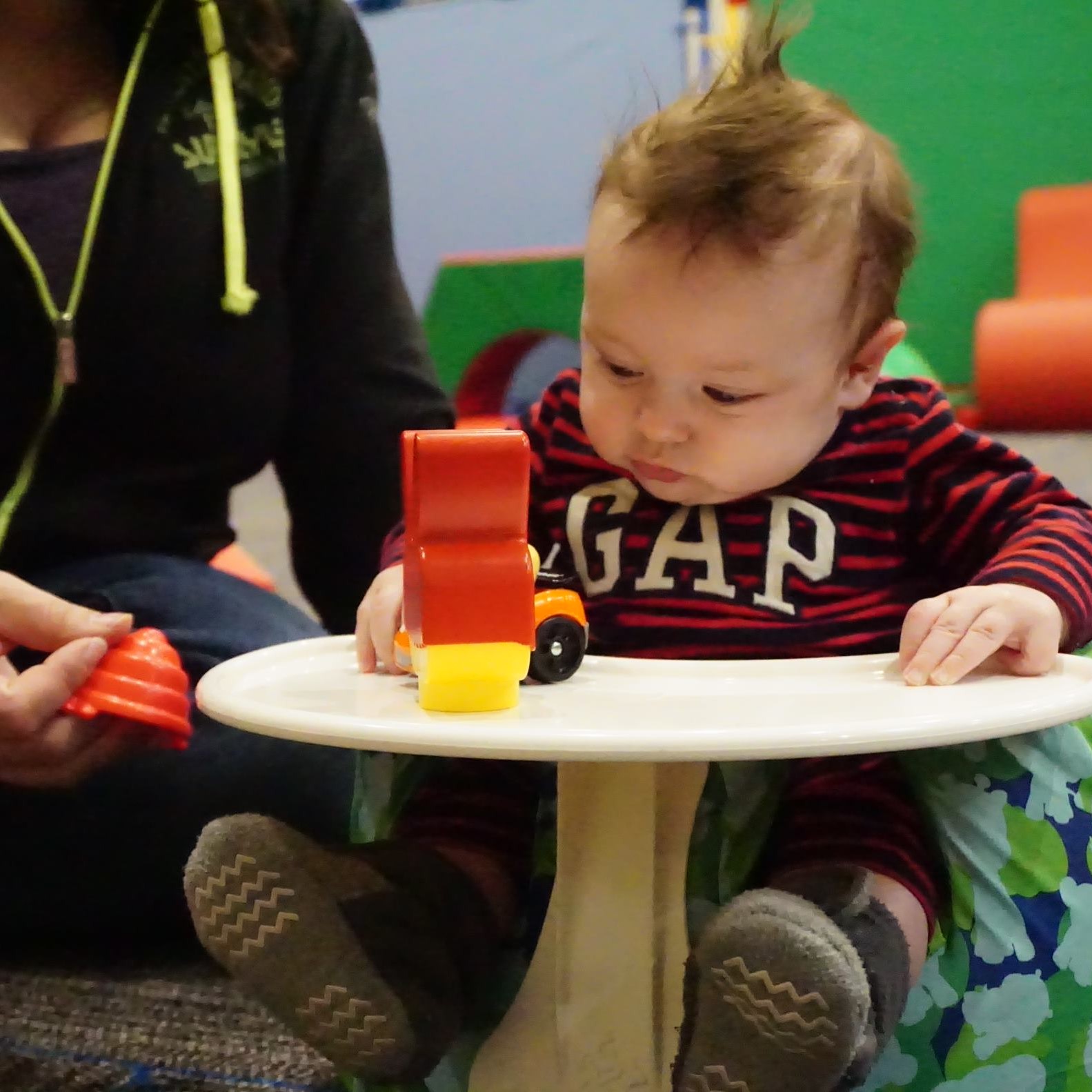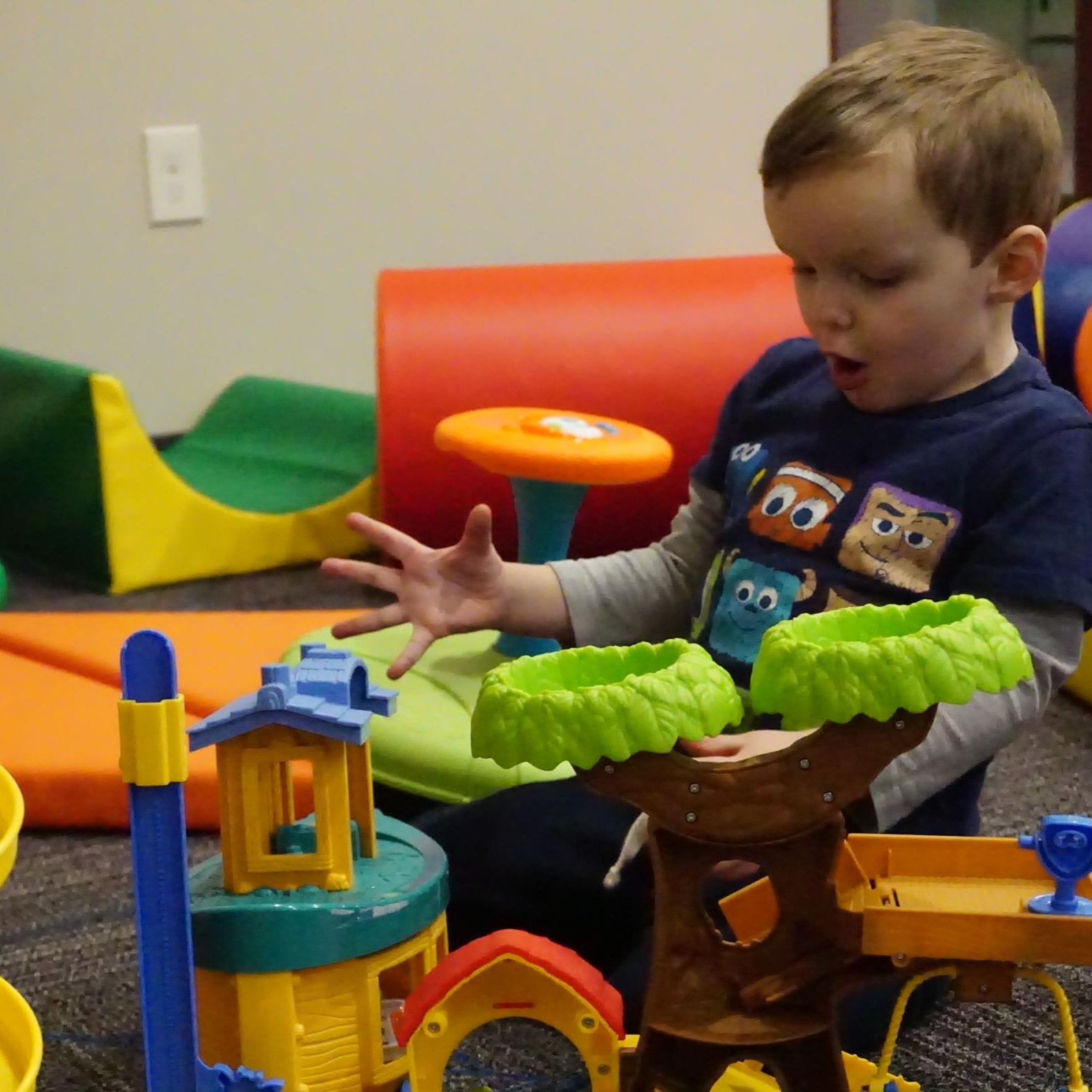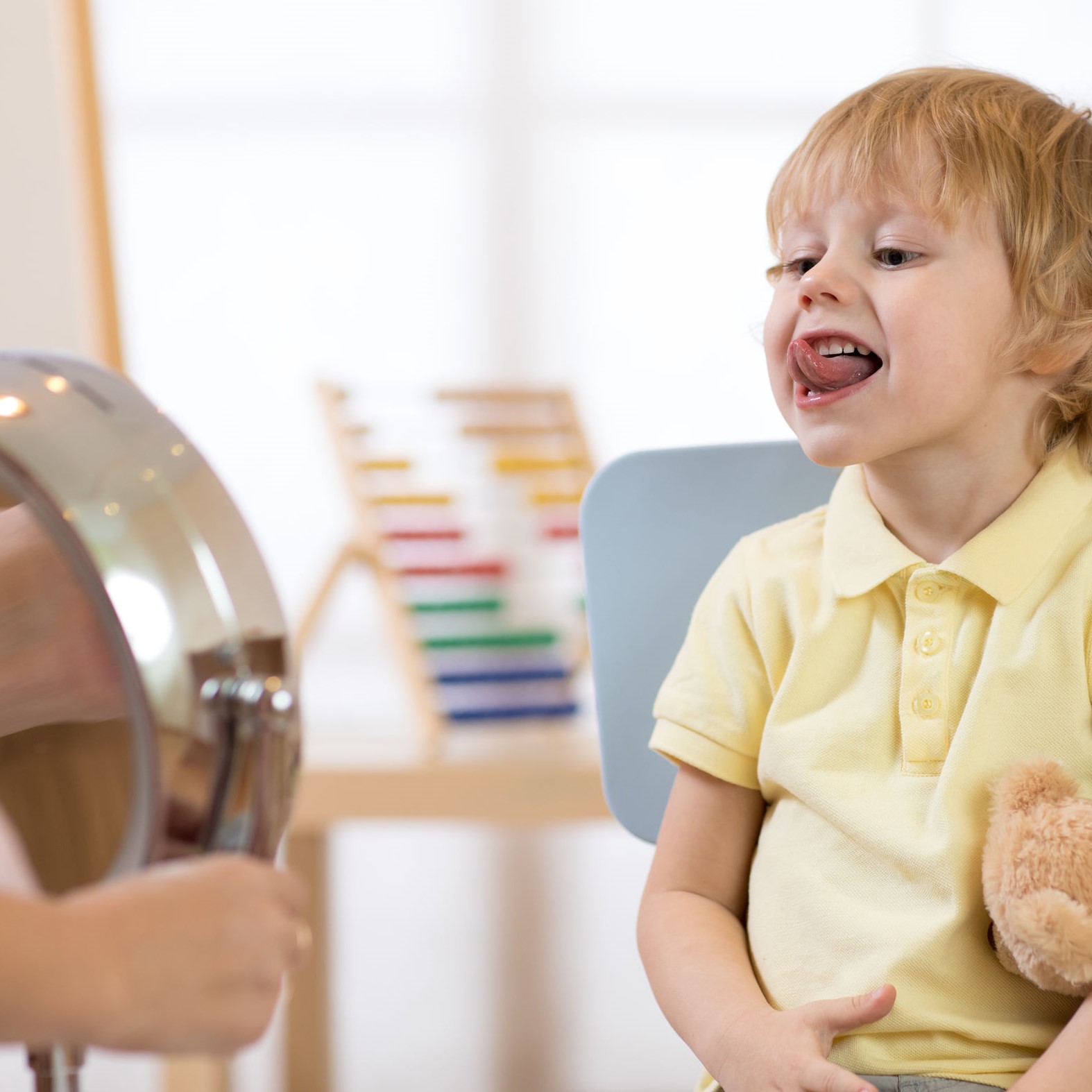Learn More



- Brief eye contact during feeding
- Cries to gain attention from others
- Responds to and calms after hearing a familiar voice
- Responds to caregiver’s face/voice and smiles
- Interested in people more than objects
- Distinguishes between an angry versus calm voice
- Attempts to imitate other’s facial expressions
- Vocalizes/coos in response to caregiver’s smile and voice
- Vocalizes 2 different sounds
- Cries when hungry
- Vocalizes to express pleasure
- Latches on to breastfeed or bottle-feed
- Baby uses coordinated suck-swallow-breathe pattern during breast/bottle feeding to efficiently consume calories
- Efficient suckle on nipple
- Sucks fingers when they are near the mouth
- Places hand(s) on the bottle when feeding
- Semi reclined posture for feeding
- Smiles and laughs spontaneously in response to others- recognize caregivers
- Stops crying after others speak to him/her
- Smiles at the reflection in the mirror
- Reaches for objects and bangs objects together
- Turns head toward heard voices and looks for speaker
- Response to sounds other than voices (e.g. bells/toys/sirens)
- Starts to respond to being told “no” (e.g. stopping an activity that may ensue danger)
- Recognizes/ shows excitement overfeeding (breast/bottle)
- Coos/ vocalizes back and forth with caregivers
- Sound-play when alone or with others
- Breastmilk and formula continue to provide the majority of caloric intake/nutrition
- The tongue begins to move without the lips
- Develops a munching pattern
- Mouths and gums solid foods
- (4-6 months of age) Spoon feeding is introduced with thin baby food cereals and thin purees (stage 1)
- Opens mouth when a spoon is presented
- Starts to use the upper lip to clear spoon
- Starts to hold a bottle
- Sits upright with the assistance
- Holds head steady without assistance
- Shows some separation anxiety
- Shouts/vocalizes when seeking attention from others
- Smiles/laughs during games
- Participates in games with adults (e.g. “Peek-A-Boo")
- Anticipates turn-taking/play activities
- Searches for objects that are hidden
- Reaches for reflection in mirror
- Plays with toys/objects other than mouthing/banging
- Responds with gestures (reaching up) when asked “want up?”
- Responds to being told “come here”, “no” most of the time
- Stops an activity when name is called
- Enjoys pictures/books
- Waves in response to “bye-bye”
- Vocalizes 2-syllable combinations (e.g. “baba”, “mama”, “dada”)
- Imitates duplicated syllables (e.g. “dadadada”, “babababa”, etc.)
- Vocalizes during games and songs
- Frequently mouths objects
- Feeds self puffs/meltables
- Gagging decreases as more solid foods are introduced
- Thicker purees introduced (stage 2)
- Vertical chewing pattern (munching) observed
- Sits in a more upright posture during feeding (place in highchair)
- No loss of liquid observed with breast/bottle feeding
- Drinks from an open cup held by an adult (some loss of liquid)
- Puts fingers in mouth to move food or to keep food in mouth
- Demonstrates fear with strangers
- Performs for social attention from others
- Uses gestures ( pats, pulls, tugs) and vocalizes to get attention
- Plays “Peek-A-Boo", “Pat-A-Cake
- Reaches upward when wanting to be picked up by an adult
- Waves “hi” and “bye”
- Points to objects to gain attention from others
- Resists when preferred toys/objects are removed
- Begins to play with toys appropriately (e.g. stirring with a spoon, pushing a car, etc.)
- Follows simple requests occasionally
- Looks at familiar people and objects after they are named
- Understands simple questions (e.g. “Where is your blanket?”)
- Tries to imitate adults
- Starts to identify body parts on self
- Says 1-2 words spontaneously in addition to saying “mama” and “dada” with intent/meaning
- Holds a soft cookie or cracker in the mouth (9 months)
- Bites through soft cookies/crackers (12 months)
- Chewing matures to more rotary jaw-action (emerging) instead of vertical up and down munch pattern
- Progresses to thicker purees (e.g. Stage 3)
- Clears food items from lower lips by drawing lip inward and using upper teeth to clear
- Increased upper lip activation on a spoon to clear food
- Deliberately reaches for spoon
- Introduce soft cubes of mashable food items (e.g. bananas) and soft table foods (e.g. scrambled eggs)
- Begin to wean bottle feeding and present cup (e.g. sippy cup, straw cup, 360 cup, etc.)
- Responds to other children’s vocalizations
- Starts to separate and play away from caregiver
- Initiates turn-taking routines with others
- Shakes head “no” and uses words to protest
- Hugs dolls, animals, or people
- Uses objects appropriately (e.g. brushes hair, uses a toothbrush on teeth, etc.)
- Identifies body parts on self, doll, or caregiver
- Starts to identify clothing items on self, doll, or caregiver
- Follows basic 1-step commands during play (e.g. “give me”, “put in”, “sit down”, “take out”, etc.)
- Starts to identify actions in pictures
- Says or imitates some single words such as “more”, “up”
- Starts to label familiar objects in pictures/books
- Imitates animal sounds
- Sings familiar songs
- Finds familiar objects that are not in sight (e.g. “Go get your cup in the kitchen.”)
- Starts to identify objects based upon categories (e.g. “Show me the animal.”)
- Talks more than using gestures to communicate
- Starts to ask basic questions (e.g. “What’s that?”)
- Tongue tip elevation observed
- Solid foods become child’s primary nutrition source
- Grasps spoon with hand
- Brings a full spoon to mouth
- Begins to drink through a straw
- Holds cup with both hands
- Drinks with 4-5 consecutive sips
- Usesupto 50 words instead of gestures to communicate with others
- Takes turns talking during conversation
- Uses 2 or more toys together in pretend play
- Understands the meaning of action words ( “ing” verbs)
- Produces and imitates 2-word phrases (e.g. “all gone”, “all done”)
- Identifies pictures when they are named
- Puts away toys with request
- Attempts to fix broken toys
- Starts to follow 2-step commands
- Starts to refer to self by name
- Starts to understand and use early pronouns (e.g. “me”, “my”, “your”, etc.)
- Starts to understand “yes/no” questions
- Scoops food with a spoon and brings it to mouth with spillage
- Drinks from a cup with limited spillage
- Swallows with lip closure
- Self-feeds frequently
- Chews a variety of textures
- Uses 300-450 words
- Recognizes family member names
- Produces 2-3 word phrases frequently
- Combines nouns and verbs
- Understands size concepts (e.g. “big”, “little”, etc.)
- Understands the concept of “one”
- Asks for help with personal needs
- Uses action words
- Asks questions (e.g. “Where is daddy?”, “What is that?”, “Who’s there?”, etc.)
- Shares toys with other children/turn taking
- Starts to name colors
- Refers to self using pronouns frequently (e.g. “I”, “me”, “my”, etc.)
- Starts to respond to “yes/no” questions
- Produces the following speech sounds accurately: /m/, /p/, /b/, /h/, /n/, and /w/.
- Child is able to chew/eat a variety of foods (fruit, vegetables, meats, and grains) and textures
- Bites through a variety of food thickness
- Self-feeds with little spillage
- Holds a small, open cup with little spillage
- Holds a cup with one hand
- Uses fingers to put food on fork
- Chews with lips closed
- Chews using stable rotary (circular) chew pattern
- Has a vocabulary of about 1000 words
- States name
- Acts out familiar routines
- Pretends to perform caregiver’s routines
- Follows 2-step unrelated commands
- Responds to “yes/no” questions correctly
- Uses plurals
- Uses basic prepositions (e.g. “in”, “on”, “out”, etc.)
- Shows interest in why and how things work
- Identifies parts of objects
- Responds to “wh” questions (e.g. “who”, “what”, “where”, “when”, etc.)
- Produces 3-4 word sentences
- Understands to function of objects (e.g. “Which object is something we wear on our feet?”)
- Understands descriptive concepts (big, wet, little, etc.)
- Produces –ing verbs in phrases/sentences (e.g. “I am eating.”)
- Produces the following speech sounds accurately: /m/, /p/, /b/, /h/, /n/, /w/, /t/, and /d/.
- Produces the following speech sounds accurately: /m/, /p/, /b/, /h/, /n/, /w/, /t/, /d/, /k/, /g/, /f/, “y” and “ng”.
- Relates personal experiences through verbalizations
- Engages in dramatic play (acting out scenes)
- Expresses ideas and feelings
- Demonstrates frustration if he/she is not understood
- Follows 2-3 step commands during play
- Starts to participate in rhyming games
- Talks about characters in a book
- Answers “What if” questions
- Understands negation (e.g. “Which child is not crying?”)
- Produces 4-5+ word sentences
- Tells how objects are used
- Responds to “How many” questions using quantities
- Uses possessives (e.g. “That is the boy’s cat.”)
- Identifies colors of objects
- Makes inferences based upon pictures
- Identifies categories of objects
- Understands analogies (e.g. “Bread is for eating and juice is for [drinking].”)
- Understands “more” and “most”
- Answers hypothetical questions logically (e.g. “What should you do if you feel sick?”)
- Uses words to describe a physical state (e.g. hungry, thirsty, tired, etc.)
- Has a vocabulary of over 2000 words
- Produces the following speech sounds accurately: /m/, /p/, /b/, /h/, /n/, /w/, /t/, /d/, /k/, /g/, /f/, /s/, /z/, /l/, /v/, “y”, “ng”, “ch”, “sh”, and “j”.
- Follows 3-step unrelated commands
- Uses language to resolve disputes with other children
- Speaks of imaginary conditions (e.g. “What if...” or “I hope...”)
- Understands story sequences
- Identifies shapes accurately
- Understands spatial concepts “on top”, “under”, “next to”, “in front”, “behind”, etc.
- Responds to “where” questions by giving a location
- Names objects when they are described
- Responds to “why” questions with reasoning
- Names categories of items
- Repeats sentences verbatim after they are presented verbally
- Attaches “-er” endings to indicate “one who” (e.g. teacher, winner, farmer, etc.)
- Understands time concepts “night” and “day”
- Uses adjectives to describe objects
- Uses regular past tense verbs
- Produces the following speech sounds accurately: /m/, /p/, /b/, /h/, /n/, /w/, /t/, /d/, /k/, /g/, /f/, /s/, /z/, /l/, /v/, /r/, “y”, “ng”, “ch”, “sh”, and “j”.
- Asks for meanings of words
- Asks questions to gain information
- Retells simple stories
- Identifies objects that do not belong in the same categories as others
- Understands quantity concepts (e.g. “Point to the plate that has 6cookies.”)
- Understands passive voice sentences (e.g. “Which picture shows mommy was kissed by the puppy?”)
- Formulates grammatically correct questions during play
- Describes similarities between 2 items
- Names 6+ items that fit into categories
- Understands sequential concepts “first” and “last”
- Counts items and giving the correct number
- Repairs semantic absurdities (e.g. Fix this sentence- “The boy sleeps on a bicycle.”)
- Has adult like speech
- Produces the following speech sounds accurately: /m/, /p/, /b/, /h/, /n/, /w/, /t/, /d/, /k/, /g/, /f/, /s/, /z/, /l/, /v/, /r/, “y”, “ng”, “ch”, “sh”, “j”, and “th”.
- Understands information that is read aloud
- Creates rhyming words
- Identifies initial sounds in words
- Understands rhyming words
- Defines words
- Repairs grammatical errors (e.g. Fix this sentence- “The girl saw he walking.”)
- Segments compound words (e.g. “Take away the word “boy” in “cowboy”. What is left?”)
- Makes grammaticality judgments (e.g. “Does this sentence sound right?”)
- Tells a story in sequence using grammatically correct sentences
- Tells a story with an introduction, sequence, and conclusion
- Uses irregular plurals
- Expresses quantity “empty” and “more”
Augmentative and Alternative Communication (AAC) refers to a means of communication other than talking for children who are non-verbal, limited verbally, or highly unintelligible in conversation. These children often experience increased frustration due to not being able to express wants, needs, ideas, and emotions to a variety of listeners. AAC services will help those children to communicate with a variety of listeners so frustration is decreased. Our speech-language pathologists at Big Blue Canopy have years of experience and have received various types of specialized training to provide AAC services to patients.
Examples of AAC treatment may include
- Using pictures to communicate (e.g. PECS)
- Using sign-language to communicate
- Using a speech-generating device (SGD) to communicate
- On-site we have an iPad with AAC apps and a trial SGD
Our therapists provide hands-on training for both the child and the parents so that the child is able to use the AAC system across all environments. We work closely together with parents to provide helpful home programs and services to improve the child’s ability to communicate with their individualized system. Therapists also conduct AAC evaluations where they work closely together with AAC reps from various companies to determine which speech-generating device may be the most successful for your child.
Articulation therapy targets children who experience articulation deficits and decreased speech intelligibility. Treatment targets articulation deficits by providing visual, auditory, and tactile (touch) cues. Therapist demonstrates appropriate placement for speech sounds by providing these cues. Children with phonological disorders, apraxia of speech, dysarthria, and other speech disturbances benefit from articulation therapy. Articulation therapy improves speech intelligibility so that the child is understood by a variety of listeners (familiar and unfamiliar).
Expressive language therapy targets expressive language skills that are necessary for expressing wants, needs, thoughts, ideas, and feelings. Receptive language therapy targets receptive language skills that are necessary for following directions and understanding spoken language. Children with expressive and receptive language deficits benefit from speech therapy to improve those skills crucial for expressing themselves and understanding language so that safety is ensured (e.g. expressing pain/illness and understanding directions/commands when involved in dangerous situations).
We provide treatment targeting oral motor and feeding deficits for the pediatric population. Feeding therapy targets a variety of deficits such as muscle weakness with chewing, controlling/chewing foods prior to swallowing, pacing in between bites to promote safe intake, cup/straw drinking, picky eating (increasing the variety of foods tolerated within diet), improving tongue/lip range of motion for speech sounds/feeding skills, etc. We provide parents with helpful strategies to implement at home to promote safe, efficient intake as well as increasing the variety of foods within the child’s diet.
Fluency treatment is provided to children who may be experiencing difficulty communicating due to disfluencies or stuttering. Disfluencies may be: repetition of sounds/syllables/words/phrases/sentences, interjections (use of filler words such as “like”, “um”, etc.), prolongation (sounds are elongated), blocking (airflow is shut off while speaking), etc. Fluency treatment provides children with strategies and techniques to compensate for disfluencies when they occur. Treatment also focuses on the feelings and emotions involved when children experience disfluencies or stuttering.
Pragmatic language therapy targets social communication to improve a child’s social interaction when involved in various social settings. Treatment focuses on improving pretend play skills, turn-taking, sharing, non-verbal communication skills (e.g. eye contact, personal space, posture, etc.), ways to initiate conversation, initiating questions in conversation, topic maintenance, etc. Therapists provide parents with strategies and ideas to carry over skills across a variety of environments so children are successful with making connections with peers and creating friendships.
There are a variety of skills that are necessary when making connections and building social relationships with others. These skills may not come naturally for all children. Our therapists at Big Blue Canopy are trained to work on social skills and emotional regulation with a variety of ages and diagnoses. Teaching interpersonal skills, conflict resolution, and problem-solving skills will improve the child’s social interaction and ability to make social connections with others.
Your child may benefit from treatment if they have difficulties with the following:
- Reading body language or identifying others’emotions
- Expressing their own emotions and feelings
- Self-regulation and managing emotions
- Transitions and changes in routines
- Turn-taking skills
- Engaging in joint play activities with others
- Making/keeping friends
- Initiating conversation with others
- Staying on topic in conversation
- Conversational turn-taking
- Non-verbal communication skills (e.g. eye contact, respecting others’ personal space, posture, etc.)
Therapists utilize a variety of treatment techniques such as:
- How Does Your Engine Run? to improve self-regulation
- Zones of Regulation to teach child strategies for emotional and sensory self-management
- Superflex- A Super Hero Social Thinking Program
- Peer interaction/ Participating in a group
- Turn-taking activities
- Interrupting appropriately
- Solving problems/negotiating
- Pretend play
- Social Stories to provide explanation and prepare children for various social situations they may have a difficult time experiencing (e.g. going to the doctor)
- Conversation paths to organize the flow of conversation
- Question boards to facilitate question initiation in conversation
- Conversation sticks to establish appropriate conversational turn-taking

